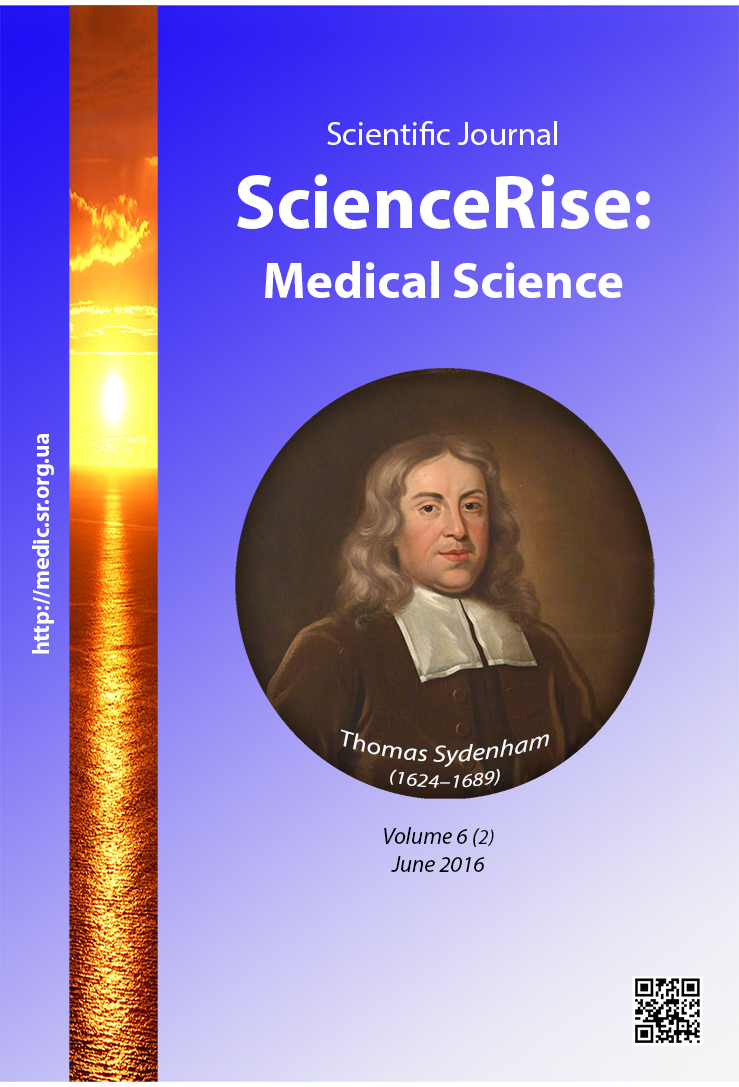Evaluation of efficacy of rehabilitation program administered to patients with incidence of gastric and duodenal ulcers
DOI:
https://doi.org/10.15587/2519-4798.2016.72756Keywords:
model, rehabilitation program, gastric ulcer, statistical substantiation, risk of recurrent hospitalization, effectivenessAbstract
Duodenal (DU) and gastric ulcer (GU) experience their rise in Ukraine, demonstrating threatening increase by 38,4 % in last decade with the prevalence of 2299 per 100 000 of population. Every second patient is treated in-patiently, every third experience disability spell annually. Reduction in related risks is confirmed not only by absence of effective therapy, but rather shortcomings in patient management and patient devotion. General belated timing of rehabilitation initiation in post hospital stage appeared to be cardinal obstacle of its efficiency with low (up to 20 %) coverage, and securing clinical effect in 8 % cases only. The goal was to evaluate efficacy of rehabilitation program detailed at first episode of in-patient treatment at gastroenterological department.
Methods. Data were organized by cohort design. Control cohort comprised 180 patients with first episode of hospitalization due to DU or GU in gastroenterological Vinnitsa city department during 2009–2012 years. Experimental cohort consisted of 220 equal patients who entered rehabilitation program (RP). RP was administered randomly. Randomness was statistically verified on principal confounders. Cases were traced for 4 years. We applied three modifications of semi-parametric frailty model to study effect of program on the risk of recurrent hospitalization.
Results. All three modifications coincided in that program secured typically at least 39 days to recurrent hospitalization per patient with drop in risk at least at RR=0,774.
Conclusion. To reduce belated timing of rehabilitation initiation, we shifted administration of rehabilitation to hospital stage. RP frame combines 10 scales, namely medication of ulcer, diet modification, overweight control, physiotherapy exercises, NSAID-induced gastropathy control management, risk factor management, blood pressure correction, diabetes management, anxiety and depression management. Program efficacy estimation relied upon time to recurrent hospitalization, which proved to be very sensitive to quality of care. Results of three survival model modifications coincided in that program secured typically at least for 39 days to recurrent hospitalization per patient with drop in risk at least at RR=0,774
References
- Arunin, L. I. (2000). Helicobacter pylori and chronicalisation of gastroduodenal ulcers. Clin. Med., 3, 60–64.
- Bereznickiy, Y. S., Stepanov, U. М., Scherbinina, M. B. (2004). To the question of contingency among therapeutists and surgeons in ulcer disease treatment. Surgery of Ukraine, 2 (10), 16–20.
- Мaiev, I. V. (2003). Modern approaches to UD treatment. Practical physician, 5, 4–8.
- Perederiy, V. G., Chernyavsky, V. V. (2005). How to treat CG, UD and to prevent gastric cancer. Lugansk: ОАО LОТ, 308.
- Petrov, V. P., Osipov, V. V. (2003). Efficacy of conservative and surgical treatment of patients with ulcer disease of duodenum. Russian journal of gastroenterology, hepathology and coloproctology, 5, 14–18.
- Order «On adoption of unified clinical protocols of medical care to the children with the digestion system diseases» (2013). MOZ of Ukraine, 59. Available at: http://www.moz.gov.ua/ua/portal/dn_20130129_0059.html
- Тkach, S. М., Nickolaeva, A. P. (2008). Modern approaches to ulcer disease treatment. Acute and first aid conditions in physician’s practice, 3-1, 5–7.
- Тkach, S. М., Nickolaeva, A. P. (2006). Modern approaches to ulcer disease treatment. Therapia, 4, 56–59.
- XXIV International Workshop on Helicobacter and related bacteria in chronic digestive inflammation and gastric cancer (2011). Dublin, Ireland.
- Duchateau, L., Janssen, P. (2008). The Frailty Model. New York: Springer, 316. doi: 10.1007/978-0-387-72835-3
- Echevin, D., Fortin, B. (2011). Physician Payment Mechanisms, Hospital Length of Stay and Risk of Readmission: a Natural Experiment. SSRN Electronic Journal. doi: 10.2139/ssrn.1919071
- Therneau, T. M., Grambsch, P. M., Pankratz, V. S. (2003). Penalized Survival Models and Frailty. Journal of Computational and Graphical Statistics, 12 (1), 156–175. doi: 10.1198/1061860031365
Downloads
Published
How to Cite
Issue
Section
License
Copyright (c) 2016 Александр Николаевич Очередько, Наталия Николаевна Кизлова

This work is licensed under a Creative Commons Attribution 4.0 International License.
Our journal abides by the Creative Commons CC BY copyright rights and permissions for open access journals.
Authors, who are published in this journal, agree to the following conditions:
1. The authors reserve the right to authorship of the work and pass the first publication right of this work to the journal under the terms of a Creative Commons CC BY, which allows others to freely distribute the published research with the obligatory reference to the authors of the original work and the first publication of the work in this journal.
2. The authors have the right to conclude separate supplement agreements that relate to non-exclusive work distribution in the form in which it has been published by the journal (for example, to upload the work to the online storage of the journal or publish it as part of a monograph), provided that the reference to the first publication of the work in this journal is included.









